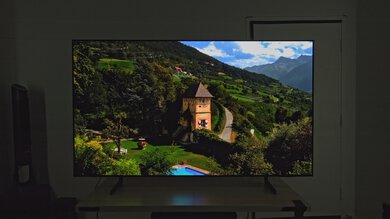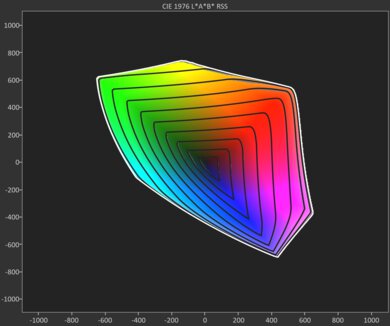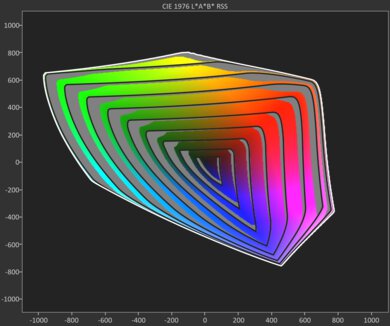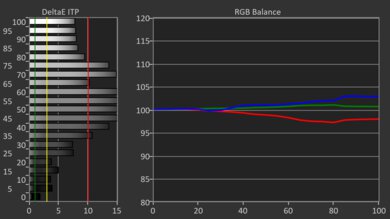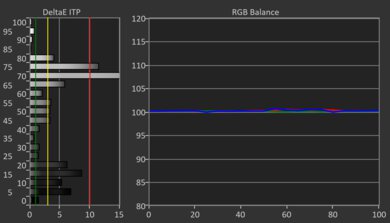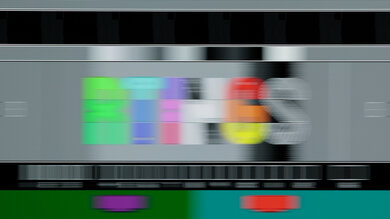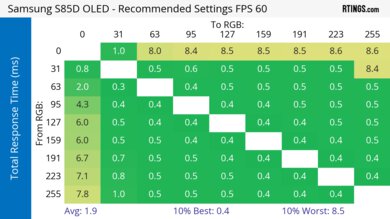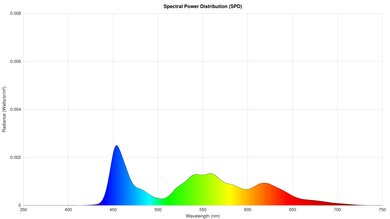The Samsung S85D OLED is Samsung's entry-level OLED for 2024. It sits below the Samsung S90D/S90DD OLED, and unlike that TV, all sizes use a traditional WOLED panel instead of a QD-OLED panel. Like the other OLEDs in Samsung's 2024 TV lineup, it uses Samsung's new NQ4 AI Gen 2 processor, designed to improve performance over their previous OLEDs. It uses the 2024 version of Samsung's Tizen OS and has smart features like the ability to cast content from your phone onto the TV and voice control. It also has modern gaming features like HDMI 2.1 bandwidth, 4k @ 120Hz, and VRR support. The TV has 20W 2.0 channel speakers built-in. We bought and tested the 65-inch model, and it's available in four different sizes: 55-inch, 65-inch, 77-inch, and 83-inch.
Our Verdict
The Samsung S85D is very good for mixed usage. It's not very bright in HDR, but thanks to its vibrant colors and perfect blacks, it still impresses in a room with the lights off. When you turn your lights on, you still get very deep blacks and saturated colors, which is great, but it does struggle with reducing the intensity of direct reflections. The TV's image quality holds up well from the sides, making it a solid option for a group setting. It's also a solid TV for gaming, with clear motion and modern gaming features.
-
Near-infinite contrast ratio for perfect blacks with no blooming around bright highlights.
-
Incredibly wide viewing angle for a consistent image from the sides.
-
Colors are vibrant and lifelike.
-
Direct reflections are distracting.
-
Lacks the SDR brightness needed to overcome glare in a bright room.
The Samsung S85D is very good for a home theater. It displays perfect blacks with no blooming thanks to its OLED technology, so despite not being very bright in HDR, highlights still stand out against darker backgrounds. Colors are vibrant enough for a good-looking image, but this is a TV you need to get calibrated if you strive for the most accurate colors possible. Fortunately, the TV does an excellent job displaying HDR content at the brightness level the filmmaker intends. It does a decent job smoothing out artifacts in low-quality content, but it doesn't remove them completely. On the other hand, it has very good upscaling, so lower-resolution content looks sharp enough to enjoy. Since the TV has a nearly instantaneous response time, you do see some stutter in movies and shows, but not everyone will notice this.
-
Near-infinite contrast ratio for perfect blacks with no blooming around bright highlights.
-
Colors are vibrant and lifelike.
-
Does a very good job upscaling low-resolution content.
-
Noticeable stutter due to the TV's fast response time.
-
No Dolby Vision and DTS audio passthrough.
The Samsung S85D is okay for a bright room. It's bright enough in SDR to fight glare from most indirect lighting, but there are some visibility issues in very bright rooms, especially during darker scenes. It also doesn't do the best job of reducing the intensity of direct reflections, so it's best to place the TV in a spot where there are no lamps or windows opposite the screen. Fortunately, colors stay well-saturated and blacks remain very deep in a bright room, so you barely lose any image quality when you turn your lights on.
-
Colors are vibrant and lifelike.
-
Blacks remain deep and colors stay vibrant in a room with ambient lighting.
-
Direct reflections are distracting.
-
Lacks the SDR brightness needed to overcome glare in a bright room.
The Samsung S85D is satisfactory for watching sports. It's bright enough to overcome glare in a room with some indirect lighting, but it lacks the direct reflection handling needed to use it in a bright room where you have the curtains open on a window that's opposite the screen. The TV does a very good job upscaling HD cable broadcasts and streams, but it doesn't completely remove artifacts from heavily compressed feeds. Fortunately, the TV's uniformity is good, so you aren't distracted by the dirty screen effect. Motion is smooth thanks to the TV's very fast response time, and you get vibrant colors that help make the big game look good. It's a solid choice for watching the game with a group of friends since the image doesn't degrade when viewed from the sides of the screen.
-
Incredibly wide viewing angle for a consistent image from the sides.
-
Nearly instantaneous pixel transitions for no noticeable blur behind fast motion.
-
Colors are vibrant and lifelike.
-
Does a very good job upscaling low-resolution content.
-
Direct reflections are distracting.
-
Lacks the SDR brightness needed to overcome glare in a bright room.
The Samsung S85D is great for gaming. It's loaded with modern features like HDMI 2.1 bandwidth on all four ports for up to 4k @ 120Hz with VRR, making it a solid pairing with the current Xbox and PlayStation consoles. It also has nearly instantaneous pixel transitions for smooth motion and low input lag for a responsive feel. The TV's HDR brightness while using Game Mode is noticeably dimmer than the other picture modes, so highlights don't pop the way they should. However, HDR games still look good due to the TV's perfect black levels and vivid colors.
-
Nearly instantaneous pixel transitions for no noticeable blur behind fast motion.
-
Colors are vibrant and lifelike.
-
Very low input lag at 120Hz for a responsive experience.
-
Noticeably dimmer in HDR while using Game Mode, which negatively impacts HDR games.
The Samsung S85D has acceptable brightness overall. It handles glare well in a room with indirect sources of light, but it's not bright enough in SDR to completely overcome glare in a well-lit room. Its HDR brightness isn't bad and highlights do stand out against darker backgrounds, but it's not quite bright enough to truly make highlights pop out in bright HDR content.
-
Lacks the SDR brightness needed to overcome glare in a bright room.
The Samsung S85D is an OLED, so it has perfect black levels. Blacks are inky in a dark room with no blooming around highlights.
-
Near-infinite contrast ratio for perfect blacks with no blooming around bright highlights.
The Samsung S85D has decent colors overall. It has very good SDR color volume, so SDR content looks nice and colorful. Its HDR color volume is only satisfactory, so although it's good enough for a solid HDR experience, it doesn't display colors at high levels of brightness. The TV's color accuracy in both SDR and HDR is alright, so colors don't look noticeably off. However, this is a TV that requires calibration if you want the most accurate colors possible.
-
Colors are vibrant and lifelike.
Note: We're in the process of improving our tests related to image processing, but this score should give you a general idea of how a TV performs overall with its image processing capabilities.
The Samsung S85D has very good processing overall. It does an excellent job displaying HDR content at the brightness level the filmmaker intends, and outside of some banding in dark blues and greens, color gradients are smooth. The TV does a very good job of upscaling low-resolution content. On the other hand, it only does a decent job smoothing out artifacts in heavily compressed content, so you still see artifacts like macro-blocking.
-
Does a very good job upscaling low-resolution content.
-
Excellent HDR brightness accuracy.
The Samsung S85D has superb responsiveness while in Game Mode. Thanks to its nearly instantaneous pixel transitions, fast motion is very clear. You also get low input lag, especially at 120Hz, so gaming feels responsive. Finally, it has support for G-SYNC, FreeSync, and HDMI Forum VRR, so you get all three of the most common forms of VRR for a nearly tear-free experience.
-
Nearly instantaneous pixel transitions for no noticeable blur behind fast motion.
-
Very low input lag at 120Hz for a responsive experience.
We're in the process of fixing the way we evaluate a TV's overall motion handling. This section is currently broken, and the score isn't indicative of how well a TV handles motion overall.
- 7.8 Mixed Usage
- 8.0 Home Theater
- 6.8 Bright Room
- 7.3 Sports
- 8.2 Gaming
Performance Usages
- 6.3 Brightness
- 10 Black Level
- 7.4 Color
- 8.0 Processing (In Development)
- 9.1 Game Mode Responsiveness
- 7.7 Motion Handling (Broken)
Changelog
- Updated May 08, 2025: Converted to Test Bench 2.0.1. We did this to fix an issue with our scoring in the Supported Resolutions section, since TVs with a refresh rate higher than 144Hz were being penalized for not supporting 144Hz.
-
Updated Apr 29, 2025:
Mentioned the newly reviewed Samsung S85F OLED in the HDR Color Volume section.
-
Updated Apr 23, 2025:
We rechecked the TV's Total Response Time and updated the result in the Response Time section.
-
Updated Apr 11, 2025:
We wrote text for the new tests and rewrote text throughout the review after updating pre-existing tests and scores for Test Bench 2.0.
- Updated Apr 11, 2025: We converted the review to Test Bench 2.0. With this new methodology, we've added new tests to expand the scope of our testing, adjusted our scoring to better align with current market conditions, and added performance usages that group related tests together to give more insight into specific aspects of a TV's performance. You can find a full list of changes in the TV 2.0 changelog.
Check Price
Differences Between Sizes And Variants
We bought and tested the 65-inch Samsung S85D, but these results are also valid for the 55-inch, 77-inch, and 83-inch models. Note that the last five letters in the model number (AEXZA in this case) vary between retailers and individual regions, but there's no difference in performance.
Best Buy sells a 77-inch variant of this TV known as the Samsung S84D (QN77S84DAEXZA/QN77S84DBEXZA) with built-in 30W 2.1 channel speakers. Otherwise, there's no difference in performance.
| Size | US Model | Short Model Code | Best Buy Exclusive (S84D) |
|---|---|---|---|
| 55" | QN55S85DAEXZA | QN55S85D | - |
| 65" | QN65S85DAEXZA | QN65S85D | - |
| 77" | QN77S85DAEXZA | QN77S85D | QN77S84D |
| 83" | QN83S85DAEXZA | QN83S85D | - |
Our unit was manufactured in April 2024.
Compared To Other TVs
The Samsung S85D is an excellent TV overall, but it doesn't really have anything special about it. Unlike the QD-OLED versions of the Samsung S90D/S90DD OLED and the flagship Samsung S95D OLED, the TV uses a traditional WOLED panel, so you don't get the same color vibrancy of those TVs. It's most comparable to a TV like LG's entry-level LG B4 OLED, but it's not as bright in HDR, and it loses a lot of peak brightness in HDR while using Game Mode. On top of that, the B4 has much better accuracy and more effective low-quality content smoothing, and it supports Dolby Vision and DTS audio passthrough. Since both TVs are similarly priced, the LG B4 OLED is the better choice for almost anyone.
For more options, check out our recommendations for the best OLED TVs, the best gaming TVs, and the best TVs at Best Buy.
The QD-OLED version of the Samsung S90D OLED is better than the Samsung S85D OLED. The S90D is a lot brighter in HDR, and it maintains its brightness much better while using Game Mode. The S90D also supports up to 4k @ 144Hz for PC gamers with high-end graphics cards. The biggest advantage of the S90D is its ability to display more vibrant and lifelike colors with almost no banding due to its QD-OLED panel. The S90D is also the more accurate TV in SDR and HDR without calibration.
The LG B4 OLED is better than the Samsung S85D OLED. The LG is brighter in HDR, and it maintains its brightness much better while using Game Mode, leading to a more impactful HDR experience. The LG is also significantly more accurate in HDR and SDR. Additionally, the LG has the edge with low-quality content smoothing, and it supports Dolby Vision and DTS audio formats.
The LG C4 OLED is better than the Samsung S85D OLED. The LG supports up to 4k @ 144Hz, so it's better suited for PC gamers looking to get the most out of their graphics cards. The LG supports Dolby Vision and DTS audio formats, so it’' better for those who want to take advantage of streaming services that use Dolby Vision or those who collect physical media. When it comes to HDR brightness, the LG is much better, delivering more impactful highlights in HDR content. The LG also has much better accuracy.
The Samsung S90C OLED is better than the Samsung S85D OLED. The S90C has a wider color gamut and much better color volume, so it displays more vibrant and lifelike colors with less banding. The S90C has much better pre-calibration SDR accuracy, so you don't need to get it calibrated if you care about accurate colors in SDR. Highlights in HDR content pop out more on the S90C due to its better HDR brightness, and it maintains that brightness while using Game Mode. If you're a PC gamer with a higher-end graphics card, the S90C supports 4k @ 144Hz, so you can play in a higher frame rate.
The LG C3 OLED is better than the Samsung S85D OLED. The LG is the brighter TV overall, so it overcomes more glare in a bright room while watching SDR content, and highlights stand out more in HDR content. The LG is more accurate in SDR due to its better pre-calibration accuracy, and it does a better job smoothing out low-quality content. If you collect physical media, the LG is the better option due to its DTS audio support, and it supports the Dolby Vision HDR format used by many streaming services and 4k Blu-rays.
The Samsung S85F OLED (QD-OLED) is a solid upgrade when compared to its predecessor, the Samsung S85D OLED. The biggest difference is that the S85F has a huge advantage in overall color performance. The S85F is also brighter in HDR, so highlights pop out a bit more on it, and it does a better job handling direct reflections. On the other hand, the S85D does a much better job of maintaining its black levels in a bright room, whereas blacks look gray on the S85F in a room with ambient lighting.
The Sony BRAVIA 8 OLED is a bit better than the Samsung S85D OLED. The Sony gets a bit brighter overall, so highlights stand out more in HDR content, and it overcomes a bit more glare in a well-lit room while watching SDR content. Unlike the Samsung, the Sony's HDR brightness isn't any dimmer while using Game Mode, so you don't have to trade in brightness for performance while gaming. The Sony also has better image processing, so it does a better job smoothing out low-quality content and a slightly better job upscaling low-resolution content. Finally, the Sony supports the popular Dolby Vision HDR format used by many streaming services and 4k Blu-rays, and it supports DTS audio formats.
Video
Test Results
The Samsung S85D has not bad HDR brightness. In combination with its remarkable contrast, it gets bright enough for some highlights to stand out, but it's not bright enough to properly display very bright highlights.
These measurements are after calibrating the HDR white point with the following settings:
- Picture Mode: FILMMAKER MODE
- Brightness: 50 (Max)
- Contrast: 50 (Max)
- Contrast Enhancer: Off
- HDR Tone Mapping: Static
- Color Tone: Warm2
- Color Space Settings: Auto
- Peak Brightness: High
If you want an OLED with better HDR brightness, take a look at the Panasonic Z85A OLED.
The Samsung S85D is noticeably dimmer while in Game Mode compared to the TV's other picture modes. This leads to a less impactful HDR experience while gaming.
These measurements are after calibrating the HDR white point with the following settings:
- HDR Picture Mode: Game Mode
- Game HDR: Basic
- Brightness: 50 (Max)
- Contrast: 50 (Max)
- Contrast Enhancer: Off
- HDR Tone Mapping: Static
- Color Tone: Warm2
- Color Space Settings: Auto
- Peak Brightness: High
The Samsung S85D has unremarkable SDR peak brightness, but it does overcome glare from indirect lighting in a moderately lit room.
These measurements are after calibration with the following settings:
- Picture Mode: Movie
- Brightness: 50 (Max)
- Peak Brightness: High
- Color Tone: Warm2
- Color Space: Auto
The TV is an OLED and has no backlight, so its self-lit pixels give it the same performance as a TV with perfect local dimming and no zone transitions. We still film the zone transition video on the TV so you can see how it compares to a TV with local dimming.
The Samsung S85D has very good SDR color volume overall. It covers most of the DCI-P3 color space, which is great. However, it struggles a lot more with the wider BT.2020 space, more so with very light and very dark shades.
| Volume ΔE³ | DCI-P3 Coverage | BT.2020 Coverage |
|---|---|---|
| L10 | 90.21% | 60.15% |
| L20 | 96.71% | 65.88% |
| L30 | 98.11% | 68.17% |
| L40 | 98.30% | 70.27% |
| L50 | 97.94% | 70.94% |
| L60 | 96.39% | 69.09% |
| L70 | 93.00% | 59.97% |
| L80 | 93.39% | 57.68% |
| L90 | 92.96% | 57.38% |
| L100 | 87.26% | 59.43% |
| Total | 95.22% | 64.14% |
The TV has satisfactory color volume. Thanks to its high contrast ratio, it can display dark, saturated colors well. On the other hand, it struggles with most colors displayed at higher luminance levels since the TV is limited by its relatively low peak brightness.
If you want a similar model with much better color volume, take a look at the 2025 successor to this TV, the Samsung S85F OLED.
The Samsung S85D has okay pre-calibration accuracy. Its white balance is disappointing, with greens very overrepresented in most grays, blues overrepresented in mid-grays, and reds underrepresented in brighter grays. The color temperature is decent, but it's noticeably cooler than our target of 6500K. Color accuracy is great, but whites lean towards cyans, and there are noticeable inaccuracies with yellows and most lighter shades. Gamma is close to our target of 2.2, but almost the entire image is brighter than intended.
The TV has fantastic accuracy after calibration. The white balance and color temperature are close to perfect. Gamma is now closer to our target of 2.2, with only very dark scenes being slightly too dark. Color accuracy is better than before, but there are still some minor inaccuracies with all colors.
See our full calibration settings.
The TV has okay HDR pre-calibration accuracy. With the exception of darker grays, blues are overrepresented, and reds are massively underrepresented in most shades. This makes the TV's color temperature drastically cooler than 6500K. The accuracy of colors is satisfactory, but there are inaccuracies throughout, and most colors are undersaturated.
The TV has great HDR accuracy after calibration. Its white balance is greatly improved, with only a bit too much blue in some brighter grays. Still, its color temperature is now significantly closer to 6500K. Unfortunately, color accuracy is pretty much the same, and most colors are undersaturated.
The Samsung S85D has excellent PQ EOTF tracking. Shadows are displayed a little bit darker than intended, but outside of that, the TV follows the curve very closely. With content mastered in 600 or 1000 nits, there's a gradual roll-off to preserve details in highlights that are brighter than the TV. With content mastered in 4000 nits, the roll-off is even more gradual to help preserve details in very bright specular highlights.
The TV does a very good job at upscaling low-resolution content like DVDs or lower-resolution streams. Details are clear enough, but fine details and small hard-coded text are hard to make out.
Sharpness processing was calibrated with no over-sharpening for low-resolution content, with the following settings:
- Sharpness: 5
The TV has very good HDR native gradient handling. There's some noticeable banding in dark greens and dark blues, but all other colors have minimal banding or no banding at all.
This TV has low input lag when set into Game Mode, which ensures a very responsive gaming experience.
The Samsung S85D supports most common resolutions up to 4k @ 120Hz. Chroma 4:4:4 signals are displayed properly with all supported resolutions when the TV's input label is set to 'PC,' which is important for text clarity.
The Samsung S85D supports all three types of variable refresh rate (VRR) technology to reduce screen tearing. It works well across a wide refresh rate range and supports sources with Low-Frame-Compensation (LFC), which ensures your games remain nearly tear-free even when your frame rate drops very low.
The Samsung S85D delivers sharp motion at its maximum refresh rate of 120Hz. There's a bit of overshoot when some shades transition from a dark state to near black, but these transitions settle quickly, so you don't notice it.
The TV is fully compatible with everything the PS5 offers, like 1440p @ 120Hz and 4k @ 120Hz, as well as HDMI Forum VRR. It also supports Auto Low Latency Mode, so you don't have to worry about manually switching to Game Mode to get the lowest input lag.
The TV is fully compatible with almost everything the Xbox Series X|S offers, including 1440p @ 120Hz, 4k @ 120Hz, HDMI Forum VRR, and FreeSync Premium Pro. It also supports Auto Low Latency Mode, so you don't have to manually switch to Game Mode to get the lowest input lag. Unfortunately, Dolby Vision isn't supported on the TV, so gaming in Dolby Vision isn't possible.
Unfortunately, due to the TV's nearly instantaneous pixel response time, there's stutter with low frame rate content, which is most noticeable during slow panning shots.
The TV automatically removes judder from all sources when watching movies or shows that are in 24p, even if they're in a 60Hz signal, like from a cable box.
Unfortunately, if you're using the BFI feature, you have to enable 'Judder Reduction,' which introduces motion interpolation.
This TV doesn't have a traditional backlight and doesn't use pulse-width modulation (PWM) to dim each pixel, but it's not completely flicker-free. There's a slight dip in brightness that corresponds to the TV's refresh rate. This differs from the PWM flicker on TVs with LED backlights and occurs on every OLED we've tested. It's not noticeable, and most people won't be bothered by this, but it can still bother people who are extra sensitive to flicker.
The TV has an optional black frame insertion (BFI) feature that reduces the appearance of persistence blur caused by the TV's nearly instantaneous response time. It can only insert black frames at a 60Hz refresh rate.
This TV has an optional motion interpolation feature to improve the clarity of motion. It does a good job of smoothing out slower scenes, with only some minor artifacts present. In faster-moving scenes, it can't keep up, and there are distracting artifacts and haloing.
The Samsung S85D has mediocre direct reflection handling. It doesn't do the best job reducing the intensity of direct reflections, so the reflections from lamps or windows opposite the screen are very noticeable.
The TV has exceptional black levels in a bright room. Black levels are barely raised in a room with ambient lighting, and they remain incredibly deep.
The TV has very good color saturation in a room with ambient lighting. Colors shown at all luminance levels barely lose any perceived saturation in a bright room, so you still get a vibrant viewing experience.
The TV has an outstanding viewing angle. There's some color shifting when the TV is viewed from an aggressive angle, but it's not too bad, and the image remains mostly consistent. It's a fantastic TV for watching content in a group setting.
The TV uses a WOLED panel with a RWBG pixel structure where all four pixels are never lit at the same time. Due to its subpixel layout, it has minor issues with displaying text on Windows since ClearType isn't well optimized to non-RGB subpixel layouts, but most users won't be bothered by this.
The white subpixel does an excellent job helping the TV display bright whites, but it dilutes the color purity of greens and reds.
The TV supports the full 48Gbps bandwidth of HDMI 2.1 on all four HDMI ports. This allows you to take full advantage of multiple high-bandwidth devices, like if you own both current-gen consoles and a high-end gaming PC. Unfortunately, Samsung still doesn't support Dolby Vision and supports HDR10+ instead, which is similar but not as widely supported. The TV also has variable analog audio out, so you can change the volume of any plugged-in analog devices, like headphones, using the remote.
Unlike Samsung's OLEDs from 2023, the S85D doesn't support ATSC 3.0 for 4k over-the-air, as Samsung has dropped that feature on their 2024 4k models.
This Samsung OLED S85D supports many audio formats, including all Dolby Digital options. Unfortunately, it doesn't support DTS formats, which is disappointing, as many Blu-rays use DTS for their lossless audio tracks.
The TV uses two plastic feet that can be adjusted to a wide position (pictured above) or a narrow position. The feet lift the TV about 3.35 inches, so most soundbars fit underneath without blocking the screen.
Footprint of the 65-inch stand in the narrow position: 12.2" x 10.39".
Footprint of the 65-inch stand in the wide position: 37.56" x 10.39".
The back of the TV is made entirely of plastic. It feels a bit loose against the panel, and the entire back of the TV flexes when pressed on. The inputs are located in two recessed cutouts on the bottom right of the TV when facing the front, which makes them hard to access if you have the TV mounted flush to the wall. The comes with two clips that can be attached to the TV's feet for cable management.
The Samsung QN65S85DAEXZA has good build quality overall. The TV is light, and the two plastic feet don't help much with weighing it down, so there's some wobble when the TV is pushed on. It's mostly made of cheap-feeling plastic, but outside of one dead pixel on the top left of our unit, there are no big concerns with the overall build quality.
The remote is identical to the one included with the Samsung S90D/S90DD OLED and the Samsung S95D OLED. It's slim and compact and has quick-access buttons for the most popular streaming apps, and is easy to use. The remote has a built-in rechargeable battery with a solar panel on the back of the remote. You can also recharge it via USB-C if it dies unexpectedly.
The TV is compatible with the Bixby and Alexa voice assistants, and its remote has an integrated microphone for voice commands. You can use your voice to launch apps, switch inputs, ask for the weather and time, and adjust certain settings like the TV's brightness.
A single button is at the bottom right of the TV. You can use it to power the TV on/off, change channels, adjust the volume, and switch inputs. You can control the TV hands-free with your voice using the built-in microphone, but you can also turn the microphone off using a small switch on the bottom right of the TV.
The TV has a decent frequency response. The sound profile is well-balanced enough at moderate listening levels that dialogue is clear, but the sound becomes more unbalanced near and at maximum volume. This is disappointing since the TV doesn't get very loud. Its speakers also don't produce meaningful bass, so you'll want to pair it with a good soundbar or surround sound system.







